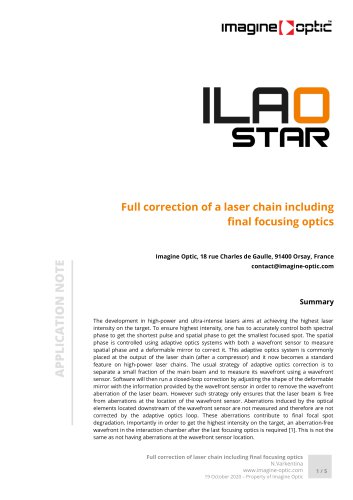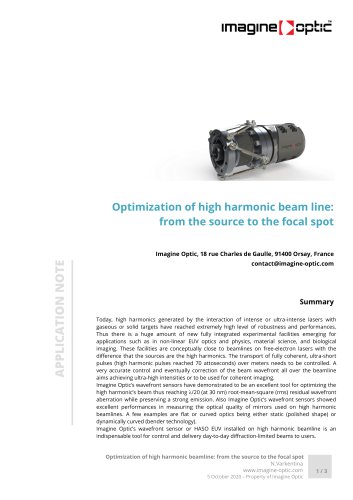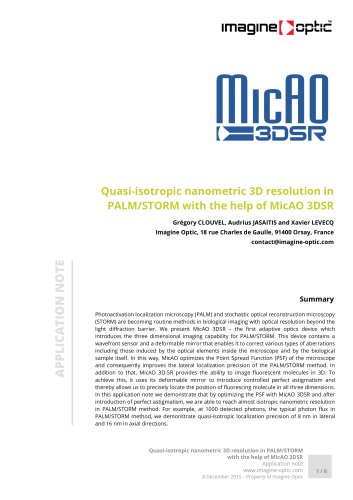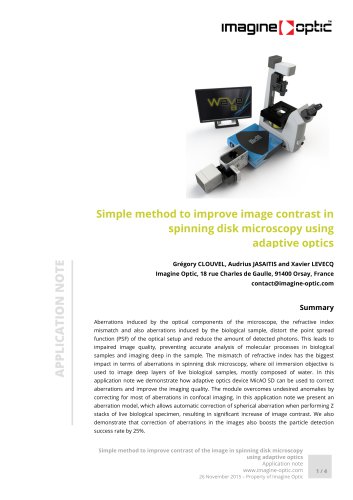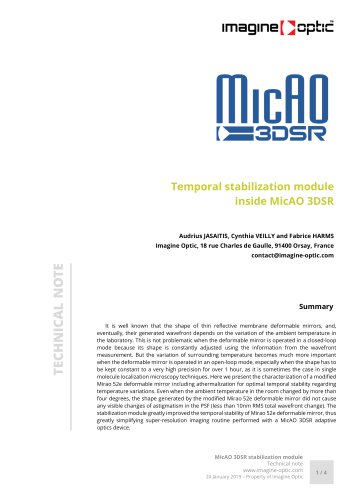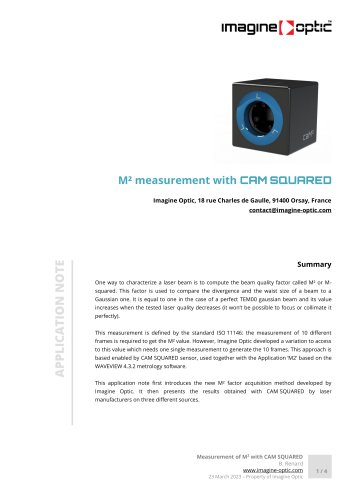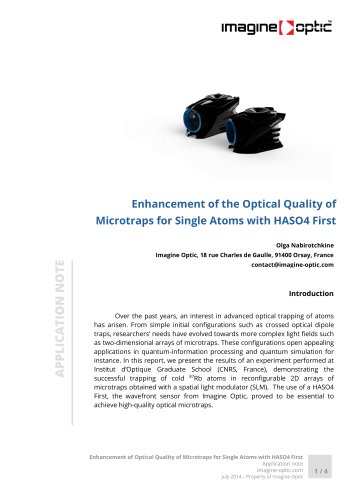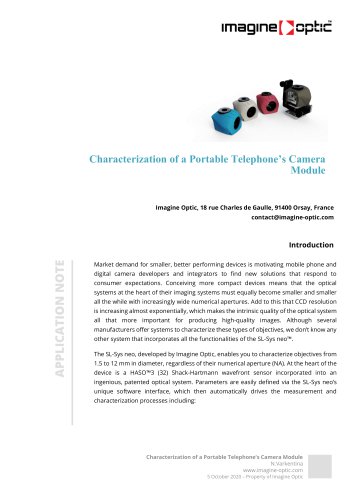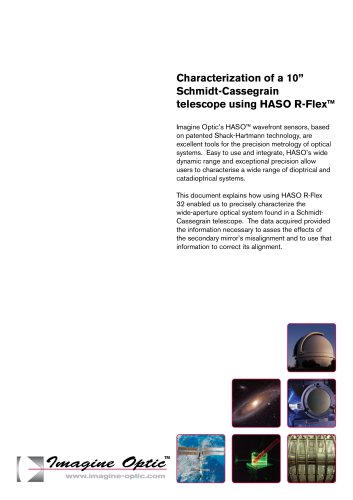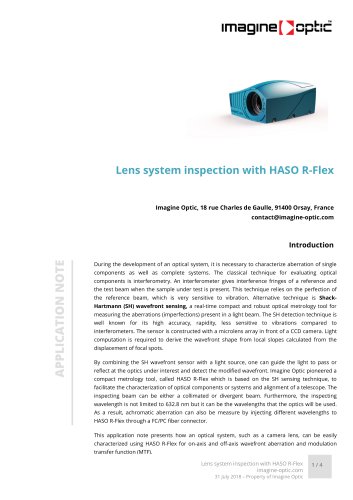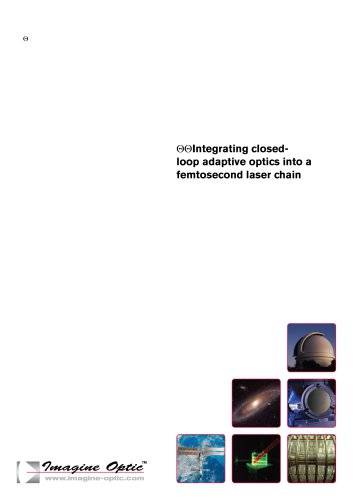
Full correction of a laser chain including final focusing optics - Laser metrology & adaptive optics Application Notes
1 /
5Pages
Catalog excerpts
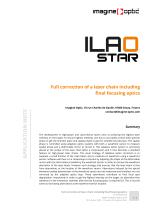
Full correction of a laser chain including final focusing optics Imagine Optic, 18 rue Charles de Gaulle, 91400 Orsay, France contact@imagine-optic.com Summary The development in high-power and ultra-intense lasers aims at achieving the highest laser intensity on the target. To ensure highest intensity, one has to accurately control both spectral phase to get the shortest pulse and spatial phase to get the smallest focused spot. The spatial phase is controlled using adaptive optics systems with both a wavefront sensor to measure spatial phase and a deformable mirror to correct it. This adaptive optics system is commonly placed at the output of the laser chain (after a compressor) and it now becomes a standard feature on high-power laser chains. The usual strategy of adaptive optics correction is to separate a small fraction of the main beam and to measure its wavefront using a wavefront sensor. Software will then run a closed-loop correction by adjusting the shape of the deformable mirror with the information provided by the wavefront sensor in order to remove the wavefront aberration of the laser beam. However such strategy only ensures that the laser beam is free from aberrations at the location of the wavefront sensor. Aberrations induced by the optical elements located downstream of the wavefront sensor are not measured and therefore are not corrected by the adaptive optics loop. These aberrations contribute to final focal spot degradation. Importantly in order to get the highest intensity on the target, an aberration-free wavefront in the interaction chamber after the last focusing optics is required [1]. This is not the same as not having aberrations at the wavefront sensor location. Full correction of laser chain including final focusing optics N.Varkentina www.imagine-optic.com 19 October 2020 – Property of Imagine Optic
Open the catalog to page 1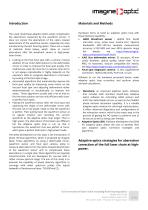
The usual closed-loop adaptive optics setup compensates the aberrations measured by the wavefront sensor. It does not correct the aberrations of the optics located downstream of the wavefront sensor, especially the ones introduced by the last focusing optics. There are a couple of methods listed below, which allow to correct aberrations after the wavefront sensor in high-power laser chains. Hardware items to build an adaptive optics loop with Phase Retrieval capability: • HASO Wavefront sensor : HASO4 first, 32x40 microlens array, active area: 3.6x4.6 mm², Spectral bandwidth: 400-1100 nm,...
Open the catalog to page 2
Figure 1. Before running adaptive optics loop, both focal spot and wavefront are aberrated. Step 1: Typical adaptive optics strategy. Before adaptive optics correction, the wavefront sensor measures aberrations presented the laser chain and also in the wavefront diagnostic’s path. The typical adaptive optics closed-loop corrects the aberrations measured by the wavefront sensor. Up to this point in the laser chain the wavefront is perfect. In order to be able to make images of the focal spot without damaging the focal spot camera, the laser chain is operated in a low-power mode by switching...
Open the catalog to page 3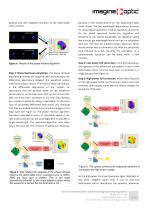
positive and then negative curvature to the deformable mirror surface. because if the measurement on the attosecond laser driver shows that the wavelength dependence prevents for using regular algorithm, it will be necessary to account for the broad spectrum inside the algorithm and therefore to use several wavelength. An algorithm taking few minutes per wavelength would end up in a calculation time over one hour for a polychromatic spectrum, which would interfer with a convenient use. With the calculation time reduced to a few seconds, the calculation of a polychromatic spectrum can be...
Open the catalog to page 4
that was giving a perfect focal spot (same wavefront as in step 4). Since differential aberrations are not power dependent, the focal spot is indeed perfect in high-power mode. For more information, please visit www.imagine-optic.com References 1) F. Canova, L. Canova, J. Chambaret, X. Levecq, E. Lavergne, G. Dovillaire, and T. Planchon, "Wavefront Correction and Aberrations Pre-Compensation in the Middle of Petawatt-Class CPA Laser Chains," inConference on Lasers and ElectroOptics/Quantum Electronics and Laser Science Conference and Photonic Applications Systems Technologies, OSA Technical...
Open the catalog to page 5All Imagine Optic catalogs and technical brochures
-
WAVE Suite
3 Pages
Archived catalogs
-
Microtraps
4 Pages
-
AO inside laser chain
5 Pages
-
AO in femtosecond laser
5 Pages
-
Large deformable mirror ILAO
6 Pages
-
NIR optics characterization
6 Pages
-
Telescope characterization
3 Pages
-
absolute measurement
4 Pages
-
HASO R.FLEX
4 Pages
-
HASO3
2 Pages
-
bendAO?
3 Pages
-
HASO?3 WSR Wavefront Sensors
2 Pages
-
HASO R-Flex
3 Pages
-
SL-Sys LIQUID
2 Pages
-
SL-Sys neo
2 Pages
-
HASO™3 Wavefront Sensors
3 Pages

